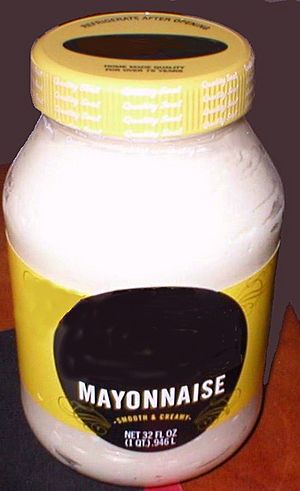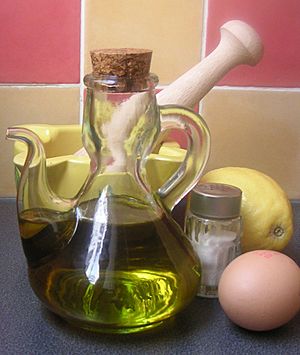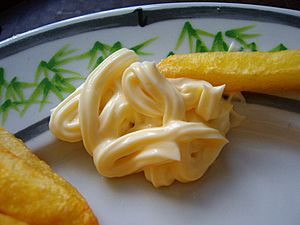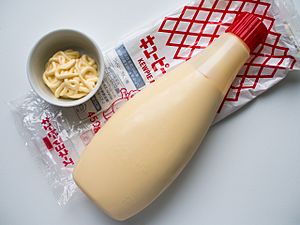Mayonnaise facts for kids
Mayonnaise, often called mayo, is a thick, cold sauce or dressing. People usually use it in sandwiches and composed salads. It is a stable mix of oil, egg yolk, and an acid. This acid is usually vinegar or lemon juice. Many types of mayonnaise have extra flavors added. The proteins and lecithin in egg yolk help mix the ingredients. This makes mayonnaise a smooth emulsion. Mayonnaise can be almost white or pale yellow. Its texture can be light and creamy or very thick.
Some versions of mayonnaise are made without eggs. These are for vegans and others. They might avoid chicken eggs or cholesterol.
Contents
The Story of Mayonnaise
A "mayonnaise de poulet" (chicken mayonnaise) was first mentioned in Paris in 1804. However, the recipe was not fully explained. In 1806, a recipe for "poulets en mayonnaise" appeared. This sauce used gelatin and vinegar. It would become thick like a jelly. Another similar sauce, called "bayonnaise," was described in 1808. It was also a jelly-like sauce. The word "mayonnaise" was first used in English in 1815.
Some believe mayonnaise might be much older. It's likely that people in the Mediterranean region, where olive oil was common, mixed oil and egg. This is similar to how aioli (oil and garlic) is made there.
How Mayonnaise is Used Around the World
Mayonnaise is popular globally. It is also a base for many other cold sauces and salad dressings. For example, sauce rémoulade is mayonnaise with added mustard, gherkins, capers, and herbs.
Mayonnaise in Chile
Chile is a big consumer of mayonnaise. It ranks third worldwide in how much mayonnaise people eat. It is first in Latin America. Commercial mayonnaise became widely available in Chile in the 1980s.
Mayonnaise in Europe
In September 1991, European guidelines were set for mayonnaise. They suggest that mayonnaise should have at least 70% oil and 5% liquid egg yolk. The Netherlands made this a law in 1998. Most brands easily meet these levels. In countries influenced by French culture, mustard is often added. Adding mustard changes the flavor. It also helps the sauce stay mixed.
Mayonnaise in Japan
Japanese mayonnaise is often made with apple cider vinegar or rice vinegar. It also has a small amount of MSG. This gives it a different taste from mayonnaise made with other vinegars. Besides salads, it is popular with dishes like okonomiyaki and takoyaki. It also goes well with katsu and karaage.
Japanese mayonnaise is usually sold in soft plastic squeeze bottles. Its texture is thicker than most Western commercial mayonnaise. This is partly because only egg yolks are used, not the whole egg. Kewpie (Q.P.) is the most famous Japanese mayonnaise brand. It uses a Kewpie doll as its logo. The Kewpie company started in 1925. Its goal was to make eating vegetables more enjoyable.
Mayonnaise in Russia
Mayonnaise is very popular in Russia. There, it is made with sunflower oil and soybean oil. A study in 2004 showed that in Europe, more mayonnaise is sold in Russia than ketchup. It is used in many popular Russian salads. These include Olivier salad and dressed herring. Leading brands are Calvé and Sloboda.
Mayonnaise in the United States
Commercial jarred mayonnaise started in Philadelphia in 1907. Amelia Schlorer began selling her own mayonnaise recipe. She had used it in salads at her family's grocery store. Mrs. Schlorer's mayonnaise quickly became popular. Her business grew into the Schlorer Delicatessen Company.
Around the same time in New York City, Richard Hellmann's delicatessen sold his wife's homemade mayonnaise. It was used in their salads. The condiment became so popular that Hellmann started selling it in "wooden boats." In 1912, Mrs. Hellmann's mayonnaise was mass-produced. It was later trademarked in 1926 as Hellmann's Blue Ribbon Mayonnaise. In the United States, mayonnaise sales are about $1.3 billion each year.
Images for kids
-
Mayonnaise from the Zaan district, North Holland, Netherlands and potato fries
See also
 In Spanish: Mayonesa para niños
In Spanish: Mayonesa para niños







